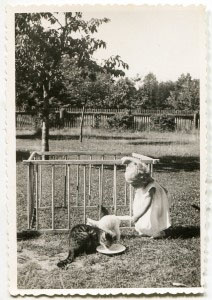The History of Pet Food
- Posted on
- By Dr. Jill Tack
- Posted in ancestral diet, history of pet food, how long has commercial pet food been around, what were pets fed before commercial pet food, when was commercial pet food invented
- 0

As you may remember from last week’s post on the ancestral diet, dogs and cats evolved on an omnivorous diet of meat and plants. It wasn’t until the 1920’s and 30’s that commercially prepared pet food became available. Before then, the only pet food that was made exclusively for pets were dog biscuit treats. As you’ll see from the timeline below, commercially prepared pet food actually has a short history despite now being the norm for the contemporary pet’s diet.
As you may remember from last week’s post on the ancestral diet, dogs and cats evolved on an omnivorous diet of meat and plants. It wasn’t until the 1920’s and 30’s that commercially prepared pet food became available. Before then, the only pet food that was made exclusively for pets were dog biscuit treats. As you’ll see from the timeline below, commercially prepared pet food actually has a short history despite now being the norm for the contemporary pet’s diet.
The 20's & 30's
Through the 1920’s and 30’s, pet food options like dehydrated, pelleted and canned food became available to those who had disposable income. These foods were made from meat and grain operation scraps. Raw meat and table scraps were fed to pets whose owners couldn’t afford commercially prepared foods, which was still the majority of pet owners at this time.
The 30’s & 40’s
The commercial pet food market evolved in the 1930’s and early ‘40s. During this time, canned pet food accounted for over 90% of the market. However, during World War II, the U.S. government categorized canned pet food as “non-essential.” So, pet owners who could afford to buy pet food had to purchase dry food or dog biscuits. Food rationing for families who couldn’t afford to buy pet food led to fewer table scraps for their pets. After the war, the boom in the consumer industry and growth of processed human foods created more food waste from which commercial pet food could now be made.
The 50’s & 60’s
With the so-called manufacturing ‘advancements’ of the 1950’s came the birth and rise of kibble. Kibble was mass produced from commercial human food waste like “grains that fail inspection, uninspected pieces and parts of waste from the seafood industry, leftover restaurant grease, deceased livestock, and even roadkill.” Pet food companies were able to mass market kibble to the country’s growing consumer base as a cheap and convenient pet food, leading it to become the most popular form of pet food. All while generating money for the food industry.
The 70’s – Today
Sadly, low quality pet foods are still the norm today. And, unfortunately, it’s taken a string of toxic pet food recalls to start raising concern about the quality of our pet’s food. Especially, with manufacturing moving overseas to cut costs, the quality of food is becoming scarier and scarier. But with this knowledge, the growing availability of safe alternative (which is really what we started with back before the 20's) pet food options, smaller independent manufacturers and the means to make our own foods, the future for our cats and dogs is bright.
The Pet Beastro was started because we wanted to educate pet parents about all the food options available and let them decide which ones are right for their lifestyle and pets' health needs. We believe that going back to the good old days doesn't seem alternative but somehow people think it is new and fan dangled. Back then it wasn't uncommon for dogs to live to the ripe old age of 20 years old. And the incidences of cancers and other chronic diseases were almost zero. Maybe our grandmas' know more than we think!
Source: Healthy Pets with Dr. Mercola
What made you make the switch to natural pet foods?


Comments
Be the first to comment...